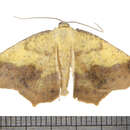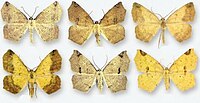en
names in breadcrumbs


Antepione sulphurata Packard 1876 : 484
Epione depontanata Grote 1864 : 90
Eutrapela furciferata Packard 1876 : 559
Gonopteryx rhomboidaria Oberthür 1912 : 246, pl. 148, f. 1401
Heterolocha sulphurata Packard 1873 : 79
Heterolocha thisoaria Guenée 1857 [1858] : 106.
Hyperythra arcasaria Walker 1860 : 131
Mimogonodes constricta Warren 1895 : 149
Sabulodes thisoaria Forbes 1948 : 108
Tetracis azonax Druce 1892 : 54, pl. 46, f. 8
Tetracis rivulata Warren 1897 : 506
Type material.
Female HT (Fig. 1), country of origin not stated [MNHN].
Fixation of type locality.
The Central American taxa were not recognized and described until 1892 (azonax) and 1912 (rhomboidaria). On this basis, I infer that specimens from this region were not available to Guenée in 1857 when he described thisoaria, and that the holotype was collected in eastern North America. In habitus, the HT matches exactly female specimens of the sulphuraria/sulphurata form. The HT was most probably collected in the Middle Atlantic region. I hereby fix the type locality as eastern North America. Based on my research, it appears that Forbes (1948) was the first to use the name thisoaria in the North American fauna.
Other material examined.
84 specimens (a few by photograph) from Alabama, Indiana, Kentucky, Mexico, Michigan, New Jersey, New York, Nova Scotia, Pennsylvania, Quebec, Tennessee, Virginia. Additional distribution records were obtainedfrom individuals and several museums, including 439 from the Carnegie Museum of Natural History, Pittsburgh, PA.
Diagnosis.
Antepione thisoaria is most easily separated from Antepione imitata based on geography. It does not occur west of the 95th parallel, while Antepione imitata extends eastwardonly to west Texas, and is not recorded from Central America. In the male genitalia, the apical region of the valva lacks spines, which are present in the valva of imitata. In the female genitalia, the corpus bursae is initially swollen while not so in Antepione imitata .
Description.
Adults. As described above for the genus. Genitalia. Figs 17-19. Two dissections (male and female) by author; illustrations in McGuffin (1987, Figs 242g, 245e) ; Pitkin (2002, Figs 202, 460) . Uncus stout, slightly decurved, tapering to a rounded tip; gnathos with unjoined slender arms, medial gnathos with a few small teeth; valva rounded at apex without spinesMale genitalia -, produced ventral ridge forming two short projections; anellus with two sclerotized spinose lobes; aedeagus truncate with one large narrow elliptical cornutus near base of vesica. Female genitalia - Apophyses long, slender; posterior apophyses ca. 1.8 × anterior apophyses; ductus bursae ridged, moderately short, partially sclerotized at posterior; corpus bursae without signum, corpus bursae without signum, oblong and initially swollen with membranous anterior sac; ductus seminalis originates at top of ductus bursae.
Biology and distribution
(Fig. 59). McGuffin (1987: 88-89) described the early stages and cited three specific larval hosts: Alnus rugosa (Du Roi) Spreng; Physocarpus opulifolius (L.) Maxim; Prunus serotina Ehrh. Various additional larval hosts are reported in the literature in the families Aceraceae , Anacardiaceae , Betulaceae , Ebenaceae , and Rosaceae . The last instar larva was illustrated by Wagner et al. (2001, p. 155) and Wagner (2005, p. 195) . Adults fly April–May with an occasional mid-March and mid-June record, July–August with occasional September to mid-October records. There is one generation in Canada, and at least two southward. The distribution map (Fig. 59) represents the data that I was able to locate. The heavy distribution in Pennsylvania reflects intensive collecting in that state by CMNH personnel and volunteers. Undoubtedly similar efforts in neighboring areas should produce additional records. The overall range of this species is: in CANADA from Nova Scotia to Manitoba; in the UNITED STATES (county records in parentheses) then south and west to the Gulf states to the 95th parallel, including Alabama (Bibb, DeKalb, Jackson, Madison, Monroe), Arkansas (Logan, Montgomery, Polk, Scott, Washington), Connecticut (Fairfield, Hartford, New Haven, New London, Tolland, Windham), Georgia (Cherokee, Rabun), Illinois (Cook, Macon), Indiana (Elkhart, Jackson, Jasper, Lagrange, Laporte, Monroe, Newton, Perry, Pulaski, St. Joseph), Iowa (Johnson, Monroe), Kansas (Crawford), Kentucky (Bell, Boone, Bracken, Bulitt, Calloway, Carter, Fayette, Graves, Harlan, Jefferson, Madison, McCracken, Meade, Menifee, Metcalfe, Morgan, Muhlenberg, Oldham, Owsley, Powell, Rowan, Russell, see Covell 1999 ), Louisiana (Feliciana Parish), Maine (Aroostook, Franklin, Oxford, Penobscot, Piscataquis), Maryland (Allegheny, Anne Arundel, Baltimore, Cecil, Garrett, Harford, Howard, Washington, Worcester), Massachusetts (Berkshire, Dukes, Essex, Middlesex, Nantucket), Michigan (Berrien, Cass, Otsego), Minnesota (Houston), Mississippi (Franklin, George, Grenada, Harrison, Kemper, Lee, Marshall, Oktibbeha, Pike, Pontotoc, Tishomingo, Union, Warren, Webster, Winston), Missouri (Barry, Benton, Camden, Cape Girardeau, Carter, Greene, Jasper, Lafayette, Lewis, Madison, Morgan, Newton, Stoddard, Warren, Wayne), Nebraska (Cass), New Jersey (Burlington, Essex, Gloucester, Morris, Passaic,Sussex , Union, Warren), New Hampshire (Rockingham), New York (Albany, Kings, Queens, Nassau, Suffolk, Westchester), North Carolina (Allegheny, Ashe, Avery, Stokes, Swain, Transylvania), Ohio (Adams, Ashland, Ross, Wayne), Oklahoma (Cherokee, see Nelson 2010 ), Pennsylvania (Adams, Allegheny, Armstrong, Beaver, Bedford, Berks, Blair, Bucks, Butler, Centre, Chester, Clearfield, Crawford, Dauphin, Fulton, Greene, Huntingdon, Lawrence, Northumberland, Perry, Somerset, Washington, Westmoreland, York), Rhode Island (Washington), South Carolina (Greenville), Tennessee (Louden, Wilson), Virginia (Augusta, Carroll, Giles), West Virginia (Cabell, Grant, Greenbrier, Hampshire, Mason, Monongalia, Monroe, Pendleton, Randolph, Roane, Wyoming); MEXICO (Michoacan state); CENTRAL AMERICA in Costa Rica and Guatemala (Pitkin et al. 1996) . Covell (1984) stated the westward range of the species to Texas. I have been unable to confirm Texas from museum records. Forbes (1948) stated: "... varieties in Colorado, Texas, and Arizona." His “varieties” are assumed to be Antepione imitata . Although the distribution map (Fig. 59) suggests occurrence of thisoaria in Florida, Vermont and Wisconsin, no records were found.
Remarks.
The gray spring form of the moth (Figs 11, 15) was described by Packard as the species furciferata. The male (Fig. 14) represents the summer form arcasaria, and the female (Fig. 16) represents the summer form sulphuraria = sulphurata. Packard (1876) redescribed Heterolocha sulphuraria Packard, 1873 as Antepione sulphurata . Once barcoding data are available, the disjunct distributions of Mexican and Central American populations may ultimately prove to be separate species, in which case the name azonax Druce, 1892 (Costa Rica, Guatemala) is available and has date priority over rhomboidaria Oberthür , 1912 (Costa Rica) and rivulata Warren, 1897 (Costa Rica). The two female specimens in the CNC from Tuxpan, Michoacan, Mexico are exact matches for the sulphuraria/sulphurata phenotype and were collected in early August, 1959.
Antepione thisoaria, the variable antepione, is a moth of the family Geometridae. In Canada it is found from Nova Scotia to Manitoba, south into the United States south and west to the Gulf states (including Alabama, Arkansas, Connecticut, Georgia, Illinois, Indiana, Iowa, Kansas, Kentucky, Louisiana, Maryland, Massachusetts, Michigan, Minnesota, Mississippi, Missouri, Nebraska, New Jersey, New Hampshire, New York, North Carolina, Ohio, Oklahoma, Pennsylvania, Rhode Island, South Carolina, Tennessee, Virginia, West Virginia), as well as Michoacan in Mexico and further south to Costa Rica and Guatemala.
The wingspan is 27–40 mm. Adult seasonally and sexually dimorphic, but the middle of the outer margin of the hindwing and forewing are conspicuously pointed in all forms, and there is usually a dark triangular patch along the costa near the apex of the forewing (although this may be absent in females). The spring brood of both sexes has mottled light brown wings (form "furciferata"). The summer brood male is bright yellow with reddish-brown shading, while the female is all yellow. Adults are on wing from April to May with an occasional mid March and mid June record as well as from July to August with occasional September to mid October records. There is one generation in Canada, and at least two southward.
The larvae have been recorded on Aceraceae, Anacardiaceae, Betulaceae, Ebenaceae and Rosaceae species, including Alnus rugosa, Physocarpus opulifolius and Prunus serotina.
Antepione thisoaria, the variable antepione, is a moth of the family Geometridae. In Canada it is found from Nova Scotia to Manitoba, south into the United States south and west to the Gulf states (including Alabama, Arkansas, Connecticut, Georgia, Illinois, Indiana, Iowa, Kansas, Kentucky, Louisiana, Maryland, Massachusetts, Michigan, Minnesota, Mississippi, Missouri, Nebraska, New Jersey, New Hampshire, New York, North Carolina, Ohio, Oklahoma, Pennsylvania, Rhode Island, South Carolina, Tennessee, Virginia, West Virginia), as well as Michoacan in Mexico and further south to Costa Rica and Guatemala.
 Variety in adults
Variety in adults The wingspan is 27–40 mm. Adult seasonally and sexually dimorphic, but the middle of the outer margin of the hindwing and forewing are conspicuously pointed in all forms, and there is usually a dark triangular patch along the costa near the apex of the forewing (although this may be absent in females). The spring brood of both sexes has mottled light brown wings (form "furciferata"). The summer brood male is bright yellow with reddish-brown shading, while the female is all yellow. Adults are on wing from April to May with an occasional mid March and mid June record as well as from July to August with occasional September to mid October records. There is one generation in Canada, and at least two southward.
The larvae have been recorded on Aceraceae, Anacardiaceae, Betulaceae, Ebenaceae and Rosaceae species, including Alnus rugosa, Physocarpus opulifolius and Prunus serotina.